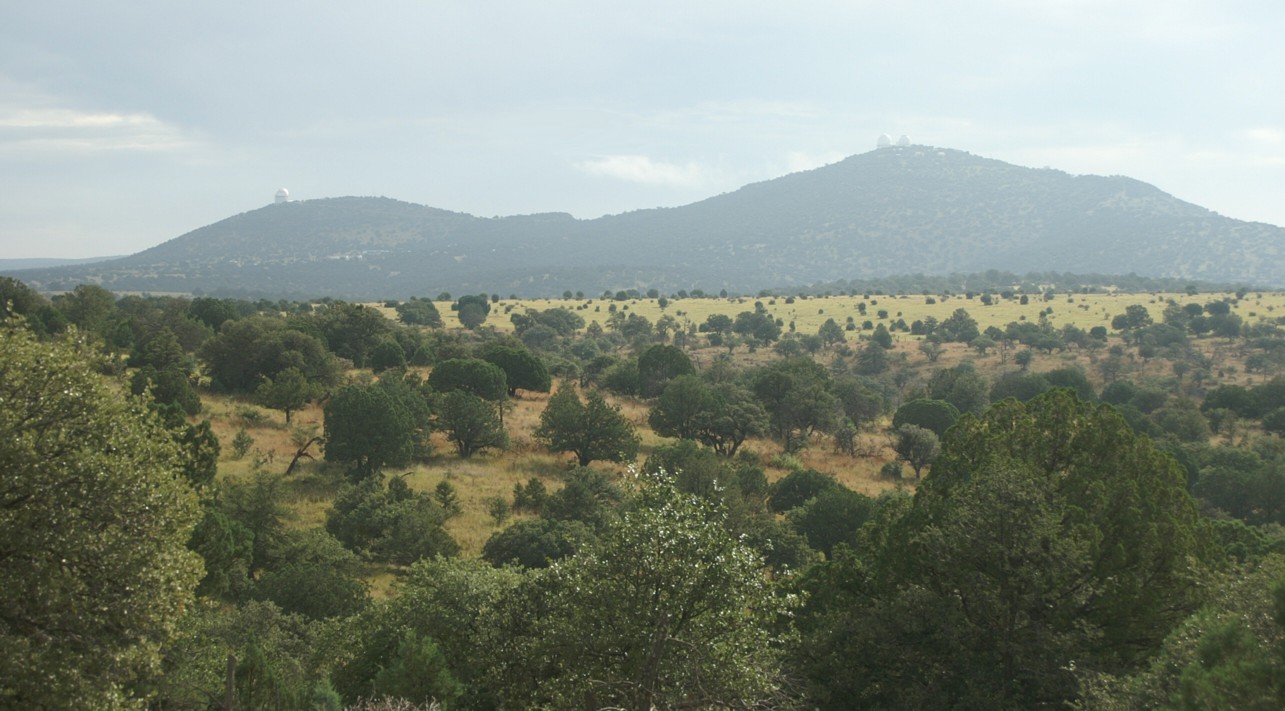
The McDonald Observatory is located in the beautiful Davis Mountains of West
Texas, north of the Big Bend area. Although the picture below is a bit
hazy due to rain, the night skies here are the darkest and clearest I have ever
seen! It is no woner why these scopes were put here by the University of
Texas. The domes sit on two peaks that are not very high above the
surrounding terrain, but are deep in a elevated volcanic plateau far from any
major town. There are three major telescopes that span the breadth of age
and design: 2.1m (82") Otto Struve Telescope finished in 1939 ("The Grand
Old Lady"), the 2.7m (107") Harlan J. Smith Telescope completed in 1968 (both on
the right mountain), and the huge 11.1 x 9.8m Hobby-Eberly Telescope (HET)
completed in 1997 (on the left). The observatory has a wonderful visitors'
center, gives great tours and has smaller scopes available for public use and
star parties.

Below is the Struve telescope dome. It was not open during our tour. It is a fairly standard equatorially mounted reflector was built by Warner & Swasey and has a dome diameter of 19 meters.

The 2.7 meter Smith telescope dome is 23 meters across.

The Smith telescope was built 30 years later than the Struve and although is
has a much more compact design, it is still an fairly standard equatorially
mounted scope in the necessarily spacious dome.

The HET, on the other hand, is a radical departure from these previous, and most other modern telescopes. The goal was great size a low cost (for its size). That necessitated some compromises, but the results are amazing. Its design is similar to the giant radio telescope at Aricebo, Puerto Rico, which as a stationary dish but a movable detector at the focus. Objects must move into the limited view of the telescope to be observed because the dish is obviously too large to do the moving. The HET goes one step farther though. While the scope is mounted at a fixed 55-degree angle above the horizon and has a tracking detector, it can rotate in azimuth. This allows it to view about 70% of the sky, but costs 80% less than a fully articulating scope of similar size. Here's a shot of the dome from the neighboring mountain. Not the little white golf ball poking up from behind the dome.

This close-up shows the lightweight geodesic design and the many ventilation shutters. Notice that it is not that much larger than the other two domes with far smaller telescopes.

Notice that the mirror is made of 91 X 1-meter hexagonal segments resting on a support truss. This huge but precision truss was made in Germany and deflects only 2.5 mm when supporting the 27,000-pound mirror! Because the mirror never moves in altitude, there is no gravitational distortion of the array. Each mirror segment has a spherical curvature rather than parabolic like most single-mirrored telescopes, which made them cheaper to produce. They are aligned by pointing them at a sensor located in the golf ball atop the Center of Curvature Alignment Sensor Tower (visible in the more distant shot). Actuators mounted behind each segment are computer controlled and can adjust each segment to within 1/3 the wavelength of light. Although the array measures 11.1 x 9.8m, it has an effective aperature of 9.2 meters, making it the 4th largest telescope.



Although the whole scope can move in azimuth (by floating on a cushion of air blown out of little holes in rubber pads kinda like a hovercraft), it is only done to place an object just out of view. Then the tracker shown below keeps the object of interest in the eyepiece as it transits across the stationary primary mirror. This telescope is optimized for spectroscopy and with its huge mirror, typically only a few minutes of transit time are needed for a successful observation. This design is so successful and, for its size inexpensive, that a similar one was set up in South Africa and even larger versions are being contemplated.
![]()
On a side note, here is the view from outside the Smith telescope. In the upper right you can see one of the radio telescopes that make up the Very Long Baseline Array.
